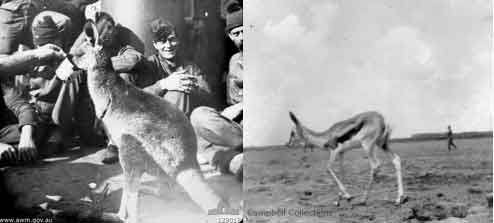
Left a wallaby on board a ship with Australian soldiers sailing for South Africa,
right a photo of a springbok taken during the Anglo-Boer War

Back to home Back to Historical
The
Van Rensburg's of Rensburg Siding, Colesberg, Cape part
1
The Anglo-Boer War Introduction
part 2
The Anglo-Boer War around
Rensburg Siding: Boer Leaders part 3
The Anglo-Boer War around
Rensburg Siding Nov 1899 part
4
The
Anglo-Boer War around Rensburg Siding Dec 1899 part
5
The
Anglo-Boer War around Rensburg Siding Jan 1900 part
6
The Anglo-Boer War around
Rensburg Siding Feb 1900 part 7
The
Anglo-Boer War in retrospect part
8
Australian units, persons and casualties part
9
MAIN
MAP source http://www.mjvn.co.za/anglo-boer/mainmap1.jpg
The Anglo-Boer War: Australians capture De Wet's artillery gun at Rensburgdrift part 10
Page 1 Page 2
The
Van Rensburg's of Rensburg Siding, Colesberg, Cape
CONTINUED
To start we need to go back a generation. Nicolaas Albertus Jansen van Rensburg was married in Mosselbaai in 1850 to Margaretha Isabella Rautenbach (daughter of Georg Frederik Rautenbach and Elsje Catharina Roelofse). He was from the farm Rietfontein in the Colesberg district and she was from the farm Brakfontein, near Mosselbaai. Nicloaas and Margaretha's membership of the Dutch Reformed Church were transferred to Colesberg from Mosselbaai on 10 August 1878, most likely to join some of the children who moved there earlier.
They
had the following children:
g1 Nicolaas
Albertus baptised
on 21 December 1851 at Mosselbaai,
married Margaretha Adriana van Schalkwyk
g2 Elsje Catharina born 2 Apr 1853, baptised 15 May 1853, married
10 Jan 1870 Petrus Jacobus Venter (In 1883 he was living on the farm Vaalkop)
g3 George Frederik (Frikkie) baptised 9 Dec 1855, became a member at Colesberg
9 Aug 1875. He married
21 Apr 1890 Amerentia Margaretha du Preez, married
again Magdalena Johanna Swanepoel
g4 Hester Catharina Susanna baptised 10 Jan 1858. She became a church member
at Colesberg on 4 Aug 1873. She married
at Colesberg, Izak Jacobus de Villiers, remarried
Oct 1886 Johan Frederik Botha (according to their childrens baptismal entries
they lived on the farm Vaalkop in 1887 and 1889)
g5 Louisa Jacobus baptised 12 Feb 1860
g6 Johannes Andries, married
Catharine Ann (Katie) Goedhals
g7 Margaretha Isabella (Grieta) baptised 15 May
1864, married
16 Feb 1891 Jacobus Philippus Bezuidenhout
g8 Dirk de Wet
g9 Louis Josephus born 16 Sept 1867, baptised 24 Nov 1867, married
Adriana Josine Meyer (witnesses at his baptism included: Louis Jacobus Janse
van Rensburg, Susanna Lamberta Zaayman, Josefus Rudolphus Janse van Rensburg,
Susanna Fourie)
g 10 Cornelis Johannes (John) born 31 May 1870, baptised Colesberg 18 Sept 1870,
married
Hester Cornelia de Plessis (witnesses
at his baptism included: Petrus Venter, Eljse Catharina Janse van Rensburg,
Cornelis Johannes Janse van Rensburg, Louisa Janse van Rensburg)
Three of these sons and their farms featured in the Anglo-Boer War. Amazingly two of the farms were the headquarters for the English and Boer forces, and one of these farms were the headquarters for both sides at different times.
The eldest son was born on 5 August 1851 and they also named him Nicolaas Albertus Jansen van Rensburg (b1 c1 d6 e1 f2 g1). This child was baptised on 21 December 1851 at Mosselbaai. The family trekked some time after 1855 and settled at the farm Taaiboslaagte, Colesberg. This is also further confirmed in personal correspondence with Jean G le Roux, who states that no Van Rensburgs owned any farms in the Colesberg area before 1855. The father passed away 24 July 1897 and the mother died 15 August 1915.
The son Nicolaas Albertus Jansen van Rensburg (b1 c1 d6 e1 f2 g1). He was accepted into Dutch Reformed church at Colesberg when he was 17 years on 8 February 1869. His sister Elsje Catharina also became a member on the same day. He got married at Philippolis on 7 April 1875 to Anna Margaretha Adriana van Schalkwyk. This couple lived on the farm Rietfontein, Arundel, a few kilometers south of Colesberg.
They
had the following children:
h1 Anna Adriana Margaretha (Attie) born 8 April 1877, baptised 21 Jan 1878 Colesberg,
married Colesberg 22 Jan 1901 Johannes Christian Rabie
h2 Margaretha Isabella born 20 Aug 1878, baptised Colesberg 1 Dec 1878, married
16 April 1902 James Charles Norval
h3 Esther Maria Violette born 30 May 1880 baptised Colesberg 1 Aug 1880 (witness
George Frederik J v Rensburg), married 8 July 1903 Nicolaas Albertus Venter
h4 Nicholina Albertina born 14 Jan 1882, baptised Colesberg 5 March 1882, married
Colesberg 22 Apr 1912 Charl Jacob du Plessis, married again Colesberg 4 Feb
1925 Ockert Jacobus Venter
h5 Nicolaas Albertus born 10 Oct 1884 baptised Colesberg 25 Jan 1884 (It is
stated that his parents were from Taaiboschlaagte), married Rachel
Susanna Elizabeth Henning (During
the ABW this boy was imprisoned when he was 16 years old. The English caught
him at the local tennis court at Colesberg. They captured him because of a letter
he wrote to his father, who was a Boer collaborator imprisoned at Tokai, Cape
Town. The young Nicolaas was sent to Port Alfred as an 'undesirable'.
h6 Maria Monica
born 20 Apr 1892, baptised Colesberg 5 Jun 1892 (Parents from Rietfontein)
witnesses included: George Fredrik Janse van Rensburg, Emarensia Janse van Rensburg,
Johan Janse van Rensburg, Gertruida Maria de Villiers.
The son Johannes
Andries van Rensburg (b1 c1 d6 e1 f2 g6) got married to Catharine Ann
Goedhals. The farm Vaalkop belonged to him.
Some
of their children were:
Jessie Cameron born 15 Aug 1908, baptised Colesberg 25 Sept 1908 (witnesses
included Cornelis Janse van Rensburg and Hester Cornelia Janse van Rensburg).
At the time of the baptism the family lived on the farm Vaalkop.
Margaretha Isabella Rautenbach born 8 Feb 1910, baptised Colesberg 1 May 1910
(witnesses included Anna Catherina Goedhals, Nicolaas Albertus Janse van Rensburg,
Violet van Rensburg
The other son Cornelis Johannes (John) van Rensburg (b1 c1 d6 e1 f2 g10) who was born 31 May 1870 and baptised at Colesberg 19 September 1870. He got married to Hester Cornelia du Plessis and they lived on the farm Taaiboslaagte (today known as Hugoslaagte). Rensburg Siding was on this farm. The railway line between Colesberg and Rosmead were opened on 17th December 1890. John van Rensburg was a so called "Rebel" according to the Cape Times.
Some
of their children were:
Anna Catharina born 7 Aug 1903, baptised 20 Sept 1903 (witnesses included Esther
Maria Violetta Janse van Rensburg, Nicolaas Albertus Venter)
Johanna Albertus born 28 Sept 1906, baptised 2 Dec 1906 (witnesses included
Johan Andries Janse van Rensburg)
Petrus du Plessis born 31 Dec 1907, baptised 17 Feb 1908
At the start of the Anglo-Boer War, Boer forces from the two Republics invaded the northern parts of the Cape and occupied the area. Colesberg was captured 13 November 1899 under the leadership of General Hendrik Jacobus Schoeman (11 Jul 1840 - 26 May 1901) and Commandant Esias Reinier Grobler (3 Jan 1861 - 31 Aug 1937). The arrival of the Boers received a lot of local support, and a number of local burghers joined the commandos. On 14 November 1899 a committee of six local members were elected to assist the Boer commandos with provisions, and what ever else they needed. One of these members were Nicolaas Albertus Janse van Rensburg, who lived at Rietfontein (on the western side of the railway line), Arundel. He was a very well known and very influential burgher in the area.
General French used the tactic of giving the impression that his forces were much larger than they really were. The Boers thus did not take the initiative with attacking.
During the Anglo-Boer War the British wanted to take control of Naauwpoort. It was a strategic position, since the railway junction from Cape Town, Port Elizabeth and Bloemfontein was situated here. A few miles north was Arundel. Ten miles north of Arundel was Rensburg Siding. Ten miles north of Rensburg Siding is the town Colesberg, see map. During the Anglo-Boer War Australians and New Zealanders served here, and a number of them were killed in battles in this area. As there was not one big battle, rather many smaller battles, the account of the Anglo-Boer War around Colesberg has not been emphasised as much.
The
British forces advanced under the command of General John DP French to Naauwpoort.
On 21 November French and his soldiers entered Arundel and found it empty. French
then went to the farm Rietfontein, which belonged to Nicolaas Albertus
Janse van Rensburg, and captured Nicolaas Albertus Janse van Rensburg at the
water canal. He was given very little time to say good bye to his family. The
British took him and left his wife and two daughters destitute. Van Rensburg
had to ride with his horse, accompanied by four British soldiers on horses,
one at the front and one at the rear, and one on each side. They rode south
and once they reached Tweedale he was transported further by train.
Apparently Van Rensburg was one of the very first Boers to be arrested in the
Colesberg area.
JM Robertson, Wrecking
the Empire, p. 34, 35 states that Van Rensburg with 8 others were imprisoned,
and it was reported that all of them were going to be shot. The Boers then arrested
9 English speaking citizens in Colesberg and helld them as hostages. Robertson
suggests that this act most probably saved Van Rensburg's life. Minister Scholz
went to speak to the Boers and told them that taking others hostage was not
the right thing. After a number of weeks all 9 English hostages were set free.
When the English took Colesberg, the former English hostages wanted vengeance,
three of them were appointed by the British to serve on a committee for the
impeachment of fellow citizens. Within 24 hours every person with Afrikaans
names were arrested, some were released after a few days. About 100 farmers
were also arrested as suspect "Rebels" and their stock were confiscated
and sold. The Magistrate at Colesberg at that time was Wrench.
In
correspondence with Belinda Gordon of Colesberg Museum she states: I do know
that 9 British citizens were imprisoned at the Court House for 96 days.
10 days kept inside
allowed out to exercise after that. They were fed by their families:
1. Arthur Scott, B.A. head master of Colesberg Collegiate School - Colesberg
Advertiser Thursday April 12th 1900 "The Cape Times gives the following
as a result of an interview with Mr Arthur Scott". "On November 23
Mr Scott was as usual taking class at his school, when an ancient Boer, Commandant
du Toit of Pilippolis, entered the room and told him he must consider himself
under arrest. Mr Scott was not very much alarmed by the appearance of the man,
who seeing that the dramatic effect of his entrance into the room had been rather
spoiled by the principal's nonchalance, produced a revolver and threatened to
shoot him. Mr Scott was then walked off under an escorted to the Court-house,
where 8 other prisoners all British - had already been sent. The Boers used
the school as a store house for fodder. He was held for 96 days.
2. T.A. Fryer, Storekeeper -let out on sick leave
3. Rev. Arthur W. Cragg, Wesleyan Minister - let out on sick leave
4. W. Hyfield, Fryer's bookkeeper - remained 96 days
5. H H Wilson, prof. of music - let out on sick leave for a few days.
6. James Key, MD - let out on parole
7. W R Devlin, proprieter Masonic Hotel - Boers used this hotel during their
occupation of the town.
8. James Mc Farlane, Storekeeper - arrested because he refused to sell to Boers
- was released on sick leave for a few days only
9. George Max King, Johannesburg refugee arrested because he showed the British
proclamation to Mr I van der rebels.
There is a photo in Kemper collection Colesberg museum of the nine.
A Mr Kolver was in charge of the prisoners until Mr Papenfus Landrost of Bloemfontein took his place and things went better for the prisoners.
There are no records in the Colesberg Advertisers since it closed down (10 Nov 1899 - 30 March 1900) when the Boers took over."
General French made his headquarters at Arundel, and on 17 December 1899 he moved into the Rietfontein farmhouse belonging to Nicolaas Albertus van Rensburg. It is not known wat happened to the homestead's furniture at the time of the occupation.
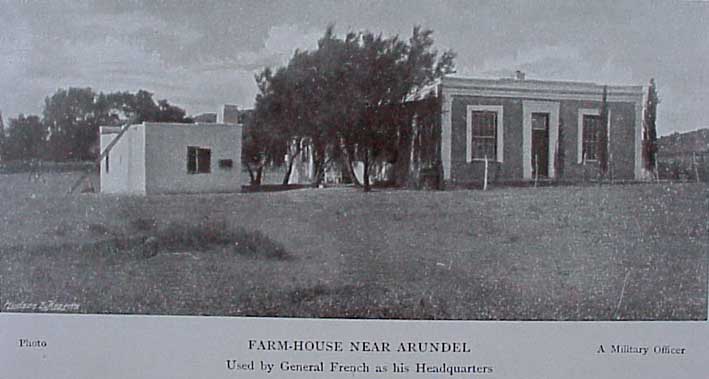
The house of
Nicolaas Albertus Jansen van Rensburg and Margaretha Adriana van Schalkwyk
on their farm Rietfontein, Arundel. General
John DP French made this his headquarters
During all these happenings the Boers were still based at Rensburg Siding on the other brother, John van Rensburg's farm, Taaiboslaagte.
On 29 December 1899 General Schoeman abandoned Rensburg Siding and retreated to Colesberg.
The next day 30 December 1899, General French occupied the home of Cornelis Johannes (John) van Rensburg and Hester Cornelia du Plessis at Rensburg Siding, and used it as his headquarters. To the dismay of the owners he stayed there for some time. We should not forget that Rensburg Siding was on the farm Taaiboslaagte / Taaiboschlaagte (today it is called Hugoslaagte). The farm house was on the eastern side of the railway line.
As the Boers succesfully attacked the English on 12 February 1900, the English soldiers were forced to retreat back to Rensburg Siding. Early on February 13th, General De la Rey attacked the headquarters at Rensburg Siding, while on the 14th February R.A.P. Clements withdrew to the nearby Arundel. The Boers thus captured Rensburg Siding.
E
J Murray wrote in his report entitled; "At The Front - and how we spent
New Year" (Written at the top of Coleskop):
"More or less
since about the 8th of December we have been continually having skirmishes with
the enemy. General French, (a very cautious General), keeps on harassing them
on all sides with artillery. For reasons unknown to us the enemy have evacuated
their position at Arundel, and Colonel Porter, of the Carabiniers, went to reconnoitre.
He found them on the kopjes outside Plewman siding. I was mounted with a telegraph
instrument and remained at Rensburg farmhouse. Being alone, more or less, the
Rensburg farmer being a rebel and having cleared with the Dutch, I turned my
attention to his poultry yard, where I commandeered four geese, two hens and
two dozen eggs. We had the two hens for dinner that night when the rest of our
fellows arrived. I gave away two geese and told the receivers to ask no questions."
From
a diary written in Colesberg in December 1899 (Held at Colesberg Museum and
information supplied by Belinda Gordon):
"The grim side of the war can be seen by visiting the Church Hall Temporary
Hospital where men with bandaged heads and limbs are being nursed, said to be
suffering from the measles. After the skirmish on Wednesday Mrs Tuiskop? [the
wife of Cornelis Johannes van Rensburg] of Taaiboschlaagte received so many
wounded Boers into her house that she could not find beds for them all &
sent to the Government School boarding dept. for a doz whole beds. The hills
E & W of Colesberg are lined with Boers & a special force of 600 is
kept at the junction ready to proceed at a moments notice to any point threatened.
The artillery fire around Arundel can be distinctly heard in Colesberg".
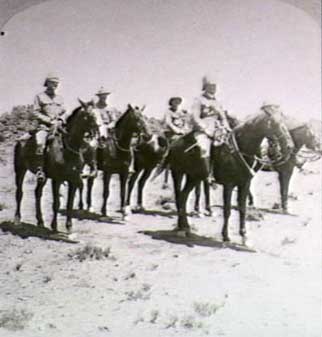
General French
and his staff 30 December 1900
after the Boers retreated from Rensburg Siding
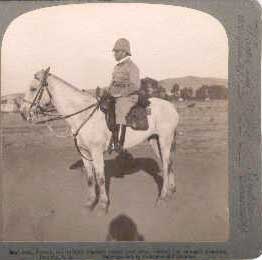
A photo of General
French
Nicolaas Albertus Janse van Rensburg spent the whole of 1900 in the police jail at Colesberg. Fortunately for him, he was allowed to receive visits from his wife and children. During March 1900 a number of other people got arrested and they were put in the same prison cell with him, Ds GA Scholtz and his son Dicke, Herman Sluiter (not the lawyer), Tobias de Villiers, P Badenhorst, Jacobus Pienaar, F Jooste Isak van Zyl, Arnoldus Meiring, Jacobus Norval, Charl Norval. In the cold winter months the freezing conditions made life very misearble in the cells. In the cell they hardly received any exercise and the food was meager.
On 10 December 1899 Van Rensburg received a visit from General Fouché, who informed him told that the English were in possession of Arundel. He then asked van Rensburg whether he could use some of his rooms at the farmhouse. Van Rensburg had no objections to this request and gave his permission accordingly.
The next day Van Rensburg was informed by Captain Kenna that his farm was broken in and that all the furniture had been destroyed. Van Rensburg also had 300 pounds in the house and found that the money mysteriously disappeared. The following day the English wanted to buy sheep, and Van Rensburg agreed to sell it at 25 shillings each. The English said that the price was to high and reduced it by half. They took the sheep, with the promise of paying later, however he never received the money from them. Shortly afterwards 65 of his cattle were stolen by the English troops from the nearby Naauwpoort.
Who
was Kenna?
"Paul Aloysius Kenna (Oakfield. Lanc 16.08.1862 - Suvla, Gallipoli 30.08.1915).
He served with the 2nd West India Regt. In 1889 he transferred to the 21st Hussars
(later Lancers). During the Anglo-Boer War he served as Asst. Provost Marshal
on General French's staff. He then served as a brigade major and in 1901 commanded
a column. Kenna then commanded the Mounted Troops during the Somaliland Campaign
and was promoted lieutenant-colonel. Kenna was an outstanding polo player. In
1905 he became a colonel and ADC to the King. In August 1914 Kenna was promoted
brigadier general in the Notts and Derby Regiment. At Gallipoli, while doing
a tour in the front lines, he was shot by a sniper and mortally wounded. Brigadier
General Kenna VC DSO is buried at Suvla Bay". Ian Uys, South African
Military Who's who 1452 1992, p. 119.
On
5 December 1900 a special court was held in Colesberg (the presiding judge was
Solomon). Seven days later, on the 12th December, Nicolaas Albertus Janse van
Rensburg (already serving one year) was sentenced to serve three and half years
in prison, and fined 500 pounds. On the 17 December he was told at 8am in the
morning, to be ready to leave at 2pm that day. There was no time to greet his
family. From the old Colesberg Station they were transported in open train trucks
to the Junction. From there they were put in enclosed cattle trucks. At Naauwpoort
they were placed on a passenger train to be taken to Cape Town. He arrived at
Tokai prison on 22 December 1900, now one man amongst 628 other prisoners. Tokai
was also a transit camp and some prisoners were sent to Bermuda or elsewhere.
The brother Andries van Rensburg from the farm Vaalkop
(the farm is situated west of Rensburg Siding and Arundel), was in 1901 sentenced
for taking up arms against Her Majesty, and murder. He was given a sentence
of death by hanging, this was changed to life imprisonment and a pound 1,000
fine. He was sent to Tokai. (He
was - g6 Johannes Andries).
Findings and sentences of Boer Rebels at Colesberg 1901 signed by R Holden Lieut
Colonel, Commandant Colesberg, District Cape Colony:
William Hofmeyer Louw. - Achtertang Colesberg District, - Taking up arms against
Her Majesty, murder, plundering: - sentence death by hanging, he was shot
Roelof Lategan - Driefontein Colesberg District- High treason - Took up weapons
against the Queenm murder - Sentence 15 years hard labour - freed at the end
of the war
Johannes Cornelius Lotter (Luther) from Colesberg District - Took up weapons
against her Majesty, murder, cruel behaviour, raliway line crimes, plundering-
Sentence Death by hanging, he was shot
Andries Stephanus Vorster - Derdepoort Colesberg District - Took up arms against
the Queen. - Sentence - 5 years prison sentence - changed to 1 year hard labour
- freed at end of war
Johannes Andries Jansen van Rensburg - Vaalkop Colesberg District - Taking up
arms against Her Majesty, murder - Sentence death by hanging, changed to life
imprisonment and pound 1,000 fine
Adrian Jacobus van Zyl - Vluchtfontein Colesberg District.- Taking up arms against
Her Majesty - Sentence death by hanging - changed to 10 years imprisonment
Petrus Jacobus van der Walt - Vogelfontein Colesberg District - Taking up arms
against Her Majesty, murder - Sentence Death by hanging - changed to life imprisonment
Frederick Toy a bricklayer, born in Gutenburg Sweden, was captured at Willomore,
tried in Graaff-Reinett 5th aug. 1901 and charged with High Treason & Attempted
Murder. Toy was accused of firing at Lieut. Wynn, after his companions in arms
had surrendered. - executed 4-9-1901
Hendrik Veenstra born in Amsterdam Holland 30th April 1879, was a book keeper
from Rietfontein in the Murraysburg district. He was said to have come to South
Africa to visit his family. He joined the Boers under Isak Liebenberg on the
3 April 1901 and was captured in the Camdeboo 14 July 1901. Veenstra was charged
with High treason & for taking part in the burning of the court-house and
another building in Murraysburg and one on Vleiplaas.executed 4-9-1901
Hendrik van Vuuren of Hottentot River in the Willomore district was said not
to speak English. His father was from Britstown. The charge High Treason - .executed
4-9-1901
Nicholas Francios van Wyk executed 11-11-1901
Johannes Cornelius Lotter (Luther) from Colesberg District - Took up weapons
against her Majesty, murder, cruel behaviour, Railway line crimes, plundering
- Sentence Death by hanging - was shot
William Hofmeyer Louw. - Achtertang Colesberg District - Taking up arms against
Her Majesty, murder, plundering - Sentence death by hanging - was shot
From the 4-9-1901 to 23-11-1901 - 5 rebels were executed at the British Camp on the Hanover Rd
At the end of the Anglo-Boer War, signed at Vereeniging, 31 May 1902, John and Andries van Rensburg with many others were POW in Bermuda and India. Whereas Nicolaas Albertus Janse van Rensburg was still in the prison at Tokai. Nicolaas Albertus was only released six months after peace was declared -- only to return to his farm destroyed by the English.
After
the War NAJ van Rensburg received 3,000 pound war damages, but he claimed that
his losses were 12,000 pounds.
*Note:
The surname originated from both a patronym and toponym. Descendants
have used "Janse van Rensburg", "Jansen van Rensburg" and
"van Rensburg" as their surname. The writer has recorded the genealogical
section according to how it was written in the original records, this explains
the variaty of ways this surname appears in this article.
Sources
A big thanks to Tannie Nelie van Rensburg from Colesberg who made her late husbands
NAJ van Rensburg's research available on request.
NAJ van Rensburg, Die Tweede Vryheidsoorlog in en om Colesberg (Unpublished
paper by b1
c1 d6 e1 f2 g1
h5 i1 (deceased 1 March 1985) of his grandfather NAJ van Rensburg of the farm
Rietfontein, Arundel). This author, N A J van Rensburg was an elder of the church
at Colesberg when simultaneously he was the Chairman of the planning committee
for the centenial anniversary of the Colesberg church in 1966, at which time
they wrote and produced the book - Ons Kerk: Ned Geref Kerk Colesberg ingewy
1866. He was also a member of the building committee responsible for the
renovations of the church and erection of the church tower, clock and weather
cock. (See photo below where he is a member of the church council).
A big thanks to the assistance of Willem and Diana Loock from Platberg, Middelburg,
Cape, South Africa who helped me obtain the primary information from Colesberg.
I also want to thank Anneli McClachlen (nee van Rensburg) living in Adelaide,
she is a descendant of NAJ van Rensburg.
Special thanks
to Mrs Belinda Gordon from the Colesberg Museum for her assistance. Refer also
to their webpage http://www.mjvn.co.za/anglo-boer/
I want to thank Alwyn P Smit, the author of Gedenkboek van M.J. de Jager
(1872 - 1939), Boerekryger, Staatsartilleris en militêr, in obtaining
material dealing with the ABO at Colesberg and for his advise.
GJ Rautenbach, Van Rensburg family tree (unpublished paper, Jan 1992)
CN Robinson, With Roberts to the Transvaal, Part 2
Suid-Afrikaanse Geslagregister, Vol 9
Colesberg Dutch
Reformed Church baptism and marriage records.
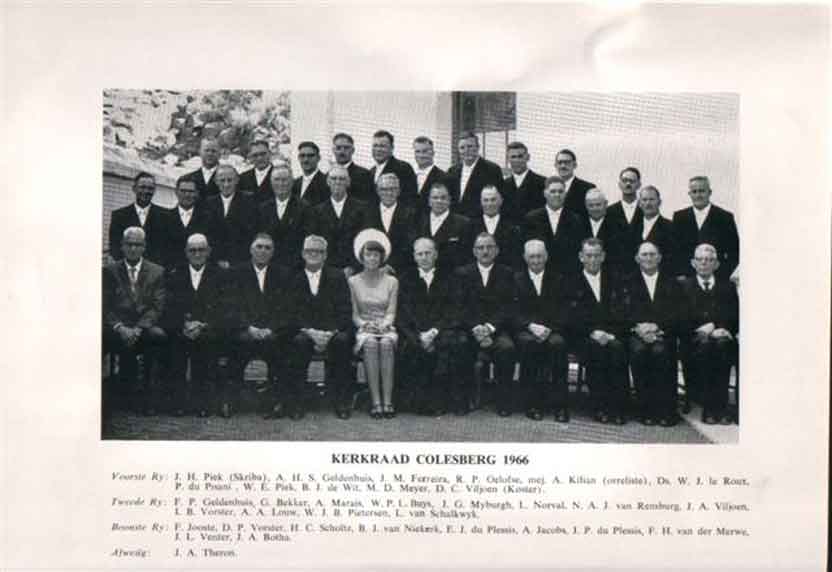
I
have not had a look at the following information:
Depot KAB
Type Accession
Ref A933
Description NAJ van Rensburg
Starting 1883 Ending 1911
Remarks Donor: NAJ van Rensburg, 1959; 0,04m; 1 vol.
Summary
+ Afrikaner Bond, Colesberg branch; Minutes 1883-1911; correspondence 1898-1911.
+ Letters received in Tokai Prison by NAJ van Rensburg from his son 1901-1902.
Town Ref # Year Marr. LDS Film #
Colesberg (g16-5/1) 1839-1846 H/Lid/Doop 2214702
Colesberg (g16-5/10) 1929-1934 H/M 2214703
Colesberg (g16-5/11) 1934-1944 H/M 2214703
Colesberg (g16-5/12) 1956-1969 H/M 2214703
Colesberg (g16-5/13) 1969-1971 H/M 2214703
Colesberg (g16-5/2) 1846-1851 H/Lid/Doop 2214702
Colesberg (g16-5/3) 1851-1862 H/M 2214703
Colesberg (g16-5/3) 1851-1862 H/Lid/Doop 2214702
Colesberg (g16-5/4) 1862-1867 H/M 2214703
Colesberg (g16-5/5) 1867-1871 H/M 2214703
Colesberg (g16-5/6) 1872-1891 H/M 2214703
Colesberg (g16-5/7) 1891-1909 H/M 2214703
Colesberg (g16-5/8) 1909-1923 H/M 2214703
Colesberg (g16-5/9) 1824-1929 H/M 2214703
Depot TAB, Type Foto, Ref 16100, Description: Ongewenstes te Port Alfred. Remarks: Geskenk deur NAJ van Rensburg, Rietfontein, Arundel, Kaap Provinsie.
Depot KAB, MOOC Vol 6/9/4330 Ref 39162. Description: Van Rensburg, Hester Cornelia. Nee du Plessis. Estate Papers. Starting 1933
Depot KAB MOOC Vol 6/9/4910 Ref 54502 Description Van Rensburg, Hester Johanna Cornelia. Nee du Plessis. Estate Papers. Starting 1937
Abraham Kruger, Stamvaders van Venterstad, Colesberg, Steynsburg, Burgersdorp, (1993)